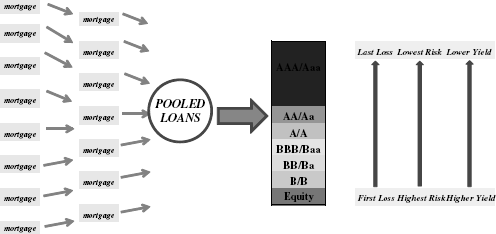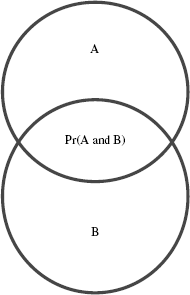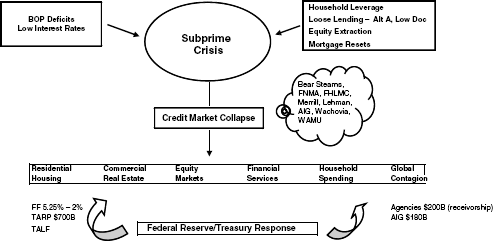Credit Enhancement
Structured finance produces a capital structure of prioritized claims known as tranches (see Figure 20.2) against the underlying pool of collateral. If constructed correctly, the CDO will provide credit enhancement for all tranches in the capital structure except for the first loss tranche (also called the equity tranche—the SPV generally retains ownership of these bonds). We now show how this works.
Figure 20.2 Structured Credit: Collateralized Mortgage Obligations

The tranches are prioritized in how they absorb losses from the underlying portfolio. Senior tranches absorb losses only after the junior claims have been exhausted, which allows senior tranches to achieve credit ratings that are higher than the average rating of the underlying pool. The degree of protection provided by junior tranches is known as overcollateralization, and it plays an important role in determining the credit rating of more senior tranches.
In its simplest form, the process of credit enhancement can best be understood by considering two securities (mortgages), each of which pays nothing upon default but one dollar otherwise (Coval et al. 2009). Both securities have the same probability of default. Suppose we combine these two securities into a $2 pool and issue two tranches against the pool. The junior tranche absorbs the first dollar loss and pays $1 in the event that neither mortgage defaults. The senior tranche pays $1 if at least one mortgage does not default. With the junior tranche absorbing the first loss, the senior tranche's credit rating is thereby enhanced, due to securitization. Assume that the default probability is equal to 10 percent on each mortgage but is uncorrelated across mortgages. The junior tranche defaults with probability equal to 19 percent while the senior tranche defaults with probability equal to 1 percent. The junior tranche defaults with probability 2 × 0.1 – 0.12. Thus, the senior tranche ends up with a credit rating that is higher than the average rating of the underlying pool. This is credit enhancement—the ability to create tranche(s) that are more secure than the underlying collateral.
Figure 20.3 shows how this probability is computed. Letting A and B represent the two mortgages, then from elementary probability theory and the knowledge that the junior tranche defaults if either bond defaults, the likelihood of the junior tranche defaulting is equal to the probability that mortgage A defaults or mortgage B defaults, minus their intersection (the joint likelihood), which translates into Pr(A) + Pr(B) – Pr(A and B) equal to 0.10 + 0.10 – 0.01 = 0.19, or 19 percent. Because the junior tranche absorbs the first loss, then the senior tranche defaults only in the event that both mortgages default together, which is Pr(A and B) = 0.12 = 0.01 or 1 percent. Clearly, the credit enhancement offered to mortgage A bonds is due in part to the assumption that defaults across mortgages are uncorrelated.
Figure 20.3 Venn Diagram of Joint Default Likelihood

As the number of securities in the pool increases, so do the prospects for credit enhancement under certain conditions. Figure 20.4 illustrates a three-tranche case. Tranche C, the most junior, defaults if any of the three bonds defaults. Tranche B defaults if two of the three bonds defaults and tranche A defaults only in the case that all three bonds default. Again, we assume that the probability of default is 10 percent and default is independent, that is, the likelihood of any bond defaulting does not depend on the likelihood of the other bonds defaulting. This is a key assumption as we shall see and, indeed, pooling bonds from diverse zip codes enhances the chances that this assumption will hold.
Figure 20.4 Venn Diagram of Joint Default Likelihood

Tranche C is junior and it defaults if any bond defaults. This is therefore the probability that A or B or C defaults (0.3) minus the intersection, which is three times 0.01, and we then add back in region 2 to avoid double counting, giving us Pr(C defaults) = 0.3 – 0.03 + 0.001 = 0.271, or 27.1 percent. Tranche B defaults if any two bonds default. There are three ways this can happen: Pr(A and B), Pr(B and C), and Pr(A and C). This is 3 × .01 = 0.03. But this has triple-counted region 2 and we should only have counted it once. Therefore, the probability of tranche B defaulting is 0.03 – 3 × 0.13 + 0.13 = 0.028 = 2.8 percent. This represents credit enhancement. Finally, the probability of tranche A defaulting depends only on all three bonds defaulting together, which is 0.001, or 0.1 percent; again, credit enhancement.
Figure 20.5 Credit Market Collapse

Now consider applying these principles to the securities in just the junior tranches of separate CDOs. Suppose, for example, that we take two CDOs’ junior tranches, each of which has a bond that defaults with probability equal to 10 percent and pool these into a new CDO (this is called a CDO2). Again, form two tranches. Under the assumption that the default correlation is still zero across bonds, either bond defaults with probability equal to 19 percent. Pr(A or B) – Pr(A and B) = 0.20 – 0.01 = 0.19. The senior tranche therefore defaults with likelihood equal to (0.19)2 = 3.6 percent. Again, there is credit enhancement.
This gives an idea on how CDOs attract investors with different risk preferences. Those wanting higher risk exposure and, consequently, higher yields, will hold bonds from the more junior tranches. More risk-averse investors will migrate to the top of the capital structure. On the other hand, if these securities were constructed as a pass-through, then all bonds would have default risk equal to 10 percent. Structured finance therefore appeals to the spectrum of risk appetites and in that sense distributes risk efficiently.
Consider now the possibility that default risks are not independent. This could happen because loan pools originate from the same zip codes or that some systemic risk event has developed that makes default dependency nonzero. In such cases, default correlations are no longer zero and the senior tranches are therefore less secure. In the extreme case in which default correlations are 1, then both tranches default with probability 10 percent and there is no credit enhancement. More to the point, intermediate default correlations can reduce credit enhancement significantly, thereby increasing the risk to investors holding these securities.
It is interesting that rating agencies like Standard and Poor's, Fitch, and Moody's used credit rating models that were basically identical to those used for other liabilities, like corporate bonds. Why would the standard credit rating model not be applicable in the case of CDOs? First, corporate credit risk is probably more heavily influenced by fundamentals within the firm and not management decisions made at other firms. Second, loans that were pooled to form CDOs (and other forms of collateralized obligations) began to gain exposure to the same sources of risk. This was especially true for regional pools of loans that originated from California, Florida, Arizona, and Nevada mortgage originations, or home equity, car, and credit card debt that were all exposed to the same macro risk factors like unemployment. As the credit crisis unfolded in 2007, SPVs were holding pools of highly correlated risks that were not being priced into the underlying tranches of the CDOs.
Historically, mortgage loans were of much shorter duration. Thus, during the depression of the 1930s, banks that found themselves with much lower reserves (due in part to their huge capital losses when equity markets imploded) could not roll over mortgage debt. As a result, homeowners who did not have the cash on hand to pay off their mortgages, found their homes foreclosed upon. The government's response was Fannie Mae and the long-term mortgage. This model worked reasonably well until the 1970s, when the explosion of money market funds sparked disintermediation of deposits from savings and loan institutions and the subsequent banking crisis, whose solution was to impose stricter capital requirements on banks. Ironically, these capital requirements are to some degree responsible for the credit crisis begun after housing prices peaked in July of 2006. Banks were required to hold more capital against their holdings of mortgage loans and CDOs than bonds issued by the GSEs. Therefore, banks accelerated the securitization of their loan originations and bought GSEs instead. GSEs, on the other hand, through tacit policies designed to promote home ownership, vastly increased their securitization of mortgage debt. Many of these pools began to show increasing signs of default stress brought on by subprime lending practices (including Alt-A and low documentation loans, high LTVs, and nonamortizing debt). Thus, the relatively low capital requirements on GSEs induced investment banks to hold large quantities of these bonds that they purchased with the proceeds of their own securitization efforts. Investment banks, for example, would create a special off-balance-sheet investment vehicle called a SIV, which would have a line of credit at a commercial bank. The SIV would sell commercial paper and use the proceeds to invest in CDOs. As long as the yield on the CDOs exceeded the yield on commercial paper, banks could safely manage huge portfolios off their balance sheet. But, as defaults began to rise and the value of the CDOs began to fall, the commercial paper market began to dry up. The SIVs then began to fail and eventually this contagion spread to the balance sheet of the investment banks themselves. Thus, SPCs and SIVs in the so-called shadow banking system (investment banks like Bear Stearns and Lehman) were getting crushed, which eventually led to huge on-balance-sheet losses as assets began to wither while liabilities remained unchanged—all because default correlations increased on the underlying collateral of CDOs.
